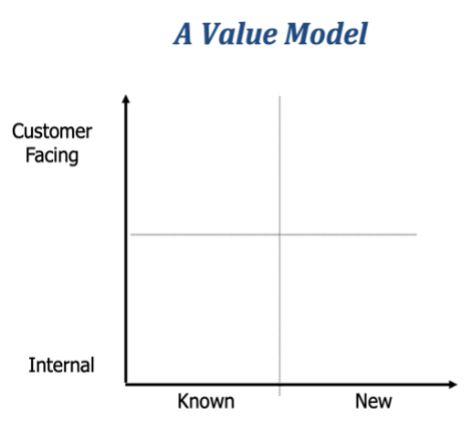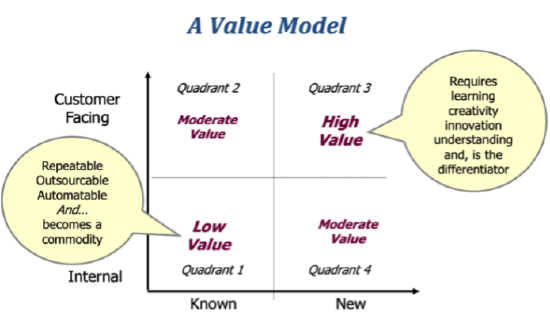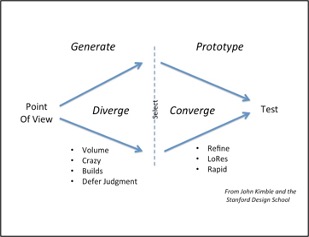Observations on Innovation
Innovation: What is it?
- Innovation is the creative use of what exists or is known to create something new and different.
- Webster: introduction of something new; a new idea, device or method
- Wikipedia: new idea applied, something substantially different, positive implications
- Wordnet: advanced or ahead the times
- Innovation in business is fractal: it needs to happen at many different levels in the organization
- New products or services (capability)
- New ways to build products and/or deliver services (capacity)
- New ways to understand customer needs and requirements (relevance)
- The innovation paradox: any idea about which we are confident is probably not very innovative
- If it is truly and substantially new, then by definition it must carry with it uncertainty and ambiguity
Innovation: Why is it Important?
- Delivering on predefined service levels is necessary. Effectively delivering on unanticipated customer needs is compelling.
- Service is a dynamic business: innovation is critical.
- Differentiation is about creating more value, faster than others.
In looking at value we will consider three things: capability, capacity, and relevance. Capability is what we can deliver. Capacity is how much and how efficiently we can deliver it. Relevance is the degree to which what we deliver aligns with customer needs and promotes sustainable relationships.
A Value Model: the critical role of innovation in business.
A helpful concept in thinking about value is the distinction of new versus known: “new” meaning a new service offering or new processes, and “known” meaning something that already exists, or a service or a process that is widely understood and practiced. In a world where change is the norm, companies and individuals have to be good at doing the “known things” as well as innovating to respond to new opportunities.
Consider the conceptual model for value. On one axis we have the nature of the interactions, moving from internal (meaning the interactions within the company or between employees) to customer facing. On the other axis we have the spectrum of known to new.
Using this grid we can create four quadrants.
 Quadrant 1, internal and known, are commodities and difficult to differentiate; they are low value. Quadrant 3, customer facing and new, represents high value and are highly differentiated. Quadrant 1 is where most business process outsourcing lives; it is a function of who can deliver on known, well-defined processes at the lowest cost. Examples of internal, known processes are back office functions like accounting or software development.
Quadrant 1, internal and known, are commodities and difficult to differentiate; they are low value. Quadrant 3, customer facing and new, represents high value and are highly differentiated. Quadrant 1 is where most business process outsourcing lives; it is a function of who can deliver on known, well-defined processes at the lowest cost. Examples of internal, known processes are back office functions like accounting or software development.
The challenge for both companies and employees is to move to a higher value quadrant where added value creates differentiation and a sustainable business relationship.
However, this requires organizations and individuals to be constantly innovating. What is new today will be known tomorrow. This dynamic re-enforces the critical role innovation plays in the service business.
How do we “Innovate”?
The best ideas are at first, laughable.
The Consortium for Service Innovation has been pursuing the creation of new and better ways to deliver customer service and support since 1992. Following are some of observations about innovation from that journey.
| Observation | Critical Attribute |
| The most creative concepts have often sparked from a laughable idea | A sense of humor |
| Willingness to try something new and unproven fosters innovation | Tolerance for uncertainty and ambiguity |
| The initial attempt at something new is seldom successful | Learning, persistence and patience |
| One idea from one person is necessary but seldom sufficient | Collaboration and the power of collective thinking |
| People with similar perspectives are less creative than a group with different perspectives | Diversity and openness |
| Progress happens when the group has a common understanding of the issue and it is something they care about | Alignment to a purpose |
| Innovation is not an agenda item | Spontaneity, flexibility |
In looking at the attributes in the right column we can see they describe culture and values, not a process. Innovation requires a high level of trust; humor is a strong indicator of trust. It also requires respect for diverse perspectives and collaboration; it is about people and interaction. Research and a number of recent books on the topic have validated these observations about innovation. For more information about innovation see The Medici Effect by Frans Johannson, The Wisdom of Crowds by James Surowiecki or Group Genius by Keith Sawyer.
Creating an Innovative Environment
Five key attributes of an innovative organization include alignment, collaboration, customer presence, tolerance for discovery, and knowledge management.
Alignment
- Alignment and influence are more powerful than command and control.
- Alignment to a compelling purpose and a set of values replaces command and control
- Alignment means that each of the players has a common view of the issue or problem
- Alignment promotes trust which enables openness and sharing
- The fun factor? “I never did a day’s work in my life; it was all fun.” – Thomas Edison
Collaboration
“Nobody every came up with a really great idea all by themselves.”
– Thomas Edison
- Recognizing the importance of collaboration and focusing on continuously increasing the relevance of interactions as well as the number and the diversity of players: relevance, reach and diversity
- Relevance – what you need when you need it (and only what you need)
- Reach – how big is the population you have visibility to, or that has visibility to you?
- Diversity – the number of different perspectives, points of view, or types of experiences represented by the players
- Termites and architecture: In his book The Medici Effect, Frans Johannson develops the idea that dramatic innovation happens at the intersection of different perspectives. It is diversity that drives innovation. Frans tells the story of Mike Pearce, an architect with the challenge of designing an office building in Zimbabwe that required no air conditioning. Zimbabwe has temperature swings from 40 to 100 degrees. Through an interest in ecology and insects, Mike came across a study of termites and how they build their nests in the desert to maintain a constant internal temperature of 78 degrees. He designed the building based on the termite nest. The world of architecture said, “Wow, that is so innovative.” Mike won an architecture award. The termites said, “So what? We have been doing it that way for thousands of years.”
Customer Presence
- “The good news is that customer-led innovation is predictably successful. The bad news is many managers and executives don’t yet believe in it.” – Patty Seybold
- Removing the arbitrary boundary that keeps our customer out of our business and finding ways to make their presence persistent.
- Use of the web to engage customers and increase presence; Submitting suggestions, voting, commenting, Q&A or forums; ratings and feedback
Tolerance for Discovery
- “I have not failed, I have just found 10,000 ways that don’t work” - Thomas Edison
- Learning is more important than success or failure
- Google developers are allowed to spend 20% of their time (1 day a week) to work on whatever projects they feel passionate about. This has produced thousands of creative ideas, a few of which are big winners. Those that aren’t are viewed as necessary learning opportunities.
Knowledge Management
- “Knowledge has to be improved, challenged and increased constantly, or it vanishes” – Peter Drucker
- Re-discovering things others already know is inefficient: a good knowledge management system can help us benefit from the collective experience.
- A knowledge management system can help improve our reach and relevance, independent of space and time. (For more on this, see the KCS pages at www.serviceinnovation.org.)
The Power of Being Provocative
It is critical that we have a clear problem statement and that those working on the problem have a common understanding of the issue. This can be a challenge when you inject diversity into the equation. People with diverse views will often perceive issues in a variety of ways.
Problem statements often suffer from dullness. Boring problem statements often lead to boring solutions. It is much more fun and therefore effective to be provocative. Bold, brash statements that cause people to react with energy are more likely to produce exciting results.
Here are a few of the provocative statements we have used to spark enthusiastic conversation and creative thinking:
- The hierarchy, as an organizational structure, has outlived its usefulness. An unbounded network structure better serves the dynamic needs of the service business (customers are part of the network).
- People are people first. The role distinction of employee, partner, or customer is often not helpful.
- Most companies are not worthy of the talent they employ. Standardized job descriptions and roles ensure that we get the least common denominator of employee productivity.
- Traditional support metrics are a great source of organizational dysfunction. Fortunately, many support analysts do the right thing in spite of them. We need to move from transaction and activity-based measures to customer value-based measures.
- The idea of managers assessing people’s contribution is a ridiculous notion. Value created should be assessed by those who realize the value.
- Control, predictability and homogeneity are death to innovation.
A Process for Innovation?
“The agenda says we’ll innovate after lunch.” Based on our experience, innovation is not an agenda item. It is hard to describe as a process, at least in traditional terms. Lots of people have tried to map a “process for innovation” but the necessary spontaneity of it makes it hard to capture as a traditional linear, prescriptive process. In our experience, innovation is not linear; it is loopy and iterative in unpredictable ways. It is a bit chaotic. It is also not time-bound. That is, some ideas have emerged and evolved in weeks or months, while others have taken six or seven years of integrating. If you want to kill innovation, apply time-bound project management disciplines.
There are two models that we have found helpful when thinking about innovation as a non-linear process.
Fading In and Out of Reality
 Most of us live at the top: consensus reality. Innovation requires an ability to move back and forth between reality and dreaming. And, it is helpful from time to time to check in with our instincts. Reflecting on or seeking to understand our instincts can be a powerful and valuable source of insight. For more on the often-overlooked power and value of our instincts, see Malcolm Gladwell’s book Blink.
Most of us live at the top: consensus reality. Innovation requires an ability to move back and forth between reality and dreaming. And, it is helpful from time to time to check in with our instincts. Reflecting on or seeking to understand our instincts can be a powerful and valuable source of insight. For more on the often-overlooked power and value of our instincts, see Malcolm Gladwell’s book Blink.
Reflecting on our instincts can move us into the dreaming or imagining state - thinking and talking about possibilities or how things could be different without the burden of reality. It is important to be explicit about where the conversation is with respect to these different states. If someone moves the conversation from the dreaming state to reality too quickly it can ruin the dream. At some point, we have to connect dreaming with reality, otherwise the ideas never get implemented.
Design Thinking
 A second helpful model when approaching innovation is one of Design Thinking. Starting with a provocative assertion, we want to explore as many possibilities as we can think of. As we mentioned some the best ideas are the ones that start out as humorous or crazy. It is critical that we defer judgment as we expand the possibilities. As the energy runs out on this, we move from expansive thinking and exploring to refining ideas and converging on something that we can do or test. Based what we learn from the results of the test we may cycle back to exploring possibilities. The model is often cyclical.
A second helpful model when approaching innovation is one of Design Thinking. Starting with a provocative assertion, we want to explore as many possibilities as we can think of. As we mentioned some the best ideas are the ones that start out as humorous or crazy. It is critical that we defer judgment as we expand the possibilities. As the energy runs out on this, we move from expansive thinking and exploring to refining ideas and converging on something that we can do or test. Based what we learn from the results of the test we may cycle back to exploring possibilities. The model is often cyclical.
Here again it is very helpful to be explicit as to where we are in the model. Conversations between people who are diverging and exploring and those who want to converge and refine are seldom productive.
Organizational Implications
If we accept the observations on the environmental attributes and the processes of innovation listed above, it is interesting to assess our organization in the context of these points. If we answer the following questions about our organization and create provocative statements about those items where we score low, it will promote some creative discussion, which will provide insight on strengthening those items.
| How well aligned are we? Are goals and values explicit and well known? | Strong Medium Weak |
| How well and broadly do we collaborate? Are there strong organizational boundaries that inhibit cross-functional collaboration? | Strong Medium Weak |
| What is the element of customer presence in our conversations? Are customers an integral part of conversations? | Strong Medium Weak |
| What is our tolerance for discovery? Do we fear failure more than we celebrate learning? | Strong Medium Weak |
| How good are we capturing and reusing what we collectively know? | Strong Medium Weak |
Closing Thoughts on Innovation
Innovation and customer presence must be integrated into the business culture. Innovation drives continuous improvement in capability and capacity and customer presence drives relevance.
- Innovation is about the organizational culture and values more than it is about a process
- Service innovation is not an agenda item or done in a lab. It is integral to everything the organization does.
- Innovation is not about being perfect; it is about making lots of mistakes and learning from them. “To have a great idea, have a lot of them.” – Thomas Edison
References
- Blink by Malcolm Gladwell
- The Medici Effect by Frans Johansson
- Group Genius by Keith Sawyer
- The Wisdom of Crowds by James Surowiecki
- Wikinomics by Don Tapscott and Anthony Williams
- Groundswell by Charlene Li and Josh Bernoff
- Outside Innovation by Patty Seybold
- The Only Sustainable Edge by John Hagel and Roger Seely Brown
- Dealing with Darwin by Geoffrey Moore
- Innovation Games
Affiliate links support the work of the Consortium.
